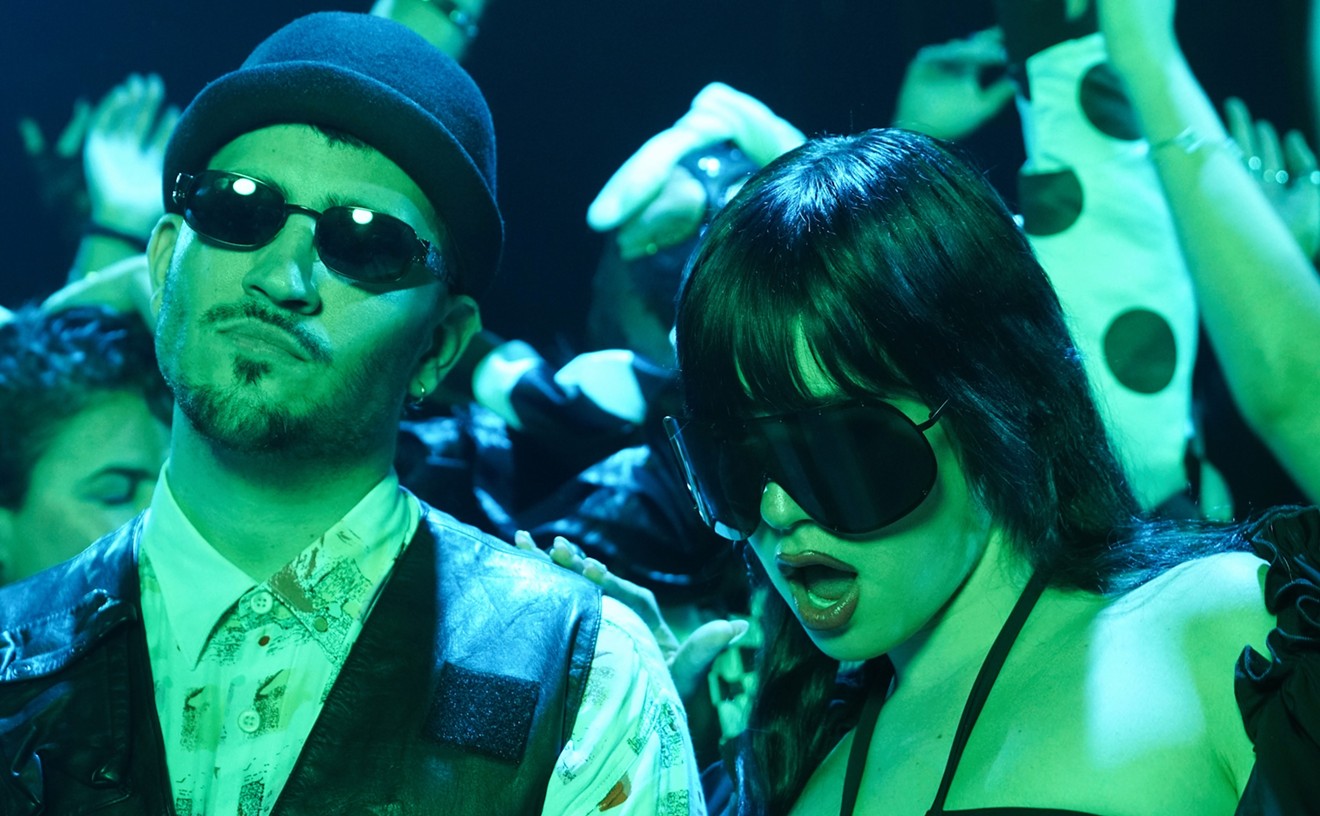It was a hot Sunday afternoon, and passersby may have wondered at the commotion. The intersection of Biscayne and NE 33rd Street was taken over by a parked cop car and a pop-up film set. At 5 o'clock, the scene was still. The crew, already tired from a long day of filming, enjoyed a picnic-style dinner of salad and barbecue on the Hamilton Apartments' north lawn.
You wouldn’t recognize the award-winning music video director on the street, but his work precedes him. He put Rick Ross in front of the Carol Mart for “Hustlin.
“I’ve worked with everyone from Akon to Lil Wayne to Drake and Nikki Minaj,” Green says. “The job never stops, but it doesn’t feel like a job when it’s your passion. I’ll do a 16-hour day, and then instead of going home and resting, I’ll write a concept. I love to do this. The fact that I’m actually able to make a salary and get paid to do something I love, it’s worth all the hard work that went in to get me here.”
That Sunday afternoon, Green and his crew were filming the video for R. City’s “Locked Away” featuring Adam Levine. The reggae-pop hit currently sits at number 14 on the Billboard pop charts, and with a week of airtime under its belt, the YouTube video already has 2.6 million views. But back in that moment, on Biscayne and NE 33rd Street, it was all still just an idea, and after an hour break for dinner, it was right back to it.
For Green, music videos are old hat. He’s got 20 years of experience and more than 150 videos under his belt. Born and raised in Miami, he went to college in New York and worked four years in Los Angeles under Michel Gondry’s company Partizan, but in the end, fate brought him home.
Thanks to the help of producer Judd Allison, he moved back to Miami and started his own company, 305 Films.
“In the height of being in L.A., career established and everything, my father got terminally ill,” he says. “The universe was saying, ‘Go spend time with your dad,' and when I did, it just so happens that I linked up with Judd Allison.”
Allison had the financial backing to produce Green’s video visions, and together, they created 305 Films.
“We did this music video called ‘We Taking Over’ for DJ Khaled,” he said. “The budget was too small for Partizan to do, and I’m like, ‘I’m not passing on this opportunity. I’ve known Khaled since he was a young DJ, Akon is my bredren, this is the track of the year. Judd was like, ‘Man, I can do it for you.’ And he shut down I-395. We were driving cars backwards on the highway, and he killed it.”
Green has had the kind of success people dream about, but it hasn't come by accident. Growing up, he attended South Miami’s magnet school for film and TV production, convincing teachers to let him make short films in lieu of traditional book reports.
His studies continued at NYU’s Tisch School of the Arts. He filmed his first music video for his thesis, a single for his old Miami group
“It was exciting being in the dorm room and seeing our video on MTV next to videos from Puff Daddy,” Green says. “That was the moment I knew I could do anything,”
After that, he landed a gig as a production assistant for Nick Quested, the guy who would give him his first break with Trick Daddy. As the millennium shifted, so too did hip-hop trends — toward the South, to be exact. Suddenly, his Miami roots were a valuable asset.
“I think my strong suit as a director is understanding the artist's world, where he’s coming from, creating visuals that have a sensibility to the artist,” Green says. “When Lil Jon first stepped on the scene, I got excited for this track called “I Don’t Give a Fuck,’ and I had this idea of doing this one-shot video of the craziest club environment in Atlanta, what he calls ‘crunk.’ I remember having a meeting with his label and pitching them, and I had to show them that I knew what crunk was.
“I basically jumped on the desk, throwing papers and acting a fool,” he laughs. “Lil Jon was like, ‘Oh, this white boy’s crazy. Let’s do the video.’”
That video ended up winning a Source Award and remains one of Green’s proudest moments. It reminds him of a simpler time, when budgets were huge and videos were larger-than-life.
Back on set, the sun has gone down and the cast and crew have gathered on 305 Film’s Toe Jam lot in Wynwood to film R. City’s party scene. They’ve got to make do with what they have, a handful of extras and some props to create an outdoor island nightclub. It’s a far cry from “I Don’t Give a Fuck.”
“You used to have to shoot on film, which was an expensive process. Now, you can shoot on your iPhone and it looks pretty amazing,” he says. “The tools are more accessible for people, and the outlets for those projects are more accessible – which I love, because now you have opportunities for a bunch of young film directors, and there’s going to be a lot more creativity.”
But every silver lining has a touch of gray.
In this business, adapting is everything, even if you are working with the biggest budgets in the world. Take the time Green filmed “Lollipop.”
“Lil Wayne had ideas of wanting to shoot in a casino, a hotel, and a club, and he wants to shoot in Vegas, and we had five days to prep it,” he says. “We think it’d be easy. It’s Vegas,
They went to every hotel on the Vegas strip and with only one night before the shoot, Lady Luck still wouldn’t sit at their table. Fueled by pressure, Green pitched filming the performance on a flatbed driving through the strip itself. Wayne loved the idea, and the video won a VMA.
“As director, you have to always steer the ship,” Green says. “There’s no excuses. If the video is a success, you get all the glory, and if it’s a failure, you get all the flack. You just have to push through.”
Maybe that’s why Green’s favorite works are the ones with a message. If you’re going to go out on a limb, you might as well make something that means something. One of his big breaks was Sizzlah’s “Thank You Momma,” and it remains one of his most rewarding. It took him to Jamaica on a tiny budget. To save money, they got the whole Rastafarian camp involved.
“They all became part of our film crew, carrying equipment across the river and stuff like that,” he says. “It became this communal
As an old-school hip-hop fan and a member of the Zulu Nation, Green appreciates the chance to spread positivity and connectedness whenever possible. That influence sat heavy on his mind when he wrote the concept for Lupe Fiasco’s “Bitch Bad,” which explored the social ramifications of hip-hop’s gender bias as well as Green’s own complex interpretations of 1920s black face and how it relates to the world we live in today.
“Hip-hop is a reflection of what’s going on,” he says, “and what’s going on in this country is materialism is being valued, so that’s what happens in the music. I don’t know if it’s life imitating art or art imitating life, but it does get mixed up, and young kids are influenced by music videos.
“Being in this era of poppin’ bottles and sexuality taking over hip-hop, it’s refreshing to get a record like Lupe’s who’s actually trying to say something,” Green says. “That’s a dream for me, because it’s like, ‘Oh wow. Now I get to be impressionable towards kids.
Which leads him to his next venture, a nonprofit film camp for inner city kids in Miami. When it all comes together next summer, he’ll be hands-on with a new generation of filmmakers, guiding them through the tricks of the trade, teaching them to create emotionally compelling pieces, all while giving back to the city that made him.
“We started 305 Films, and it just so happened all these Miami artists or other artists were moving to Miami, and Miami became a musical mecca,” he says. “The universe told me to come here… I’m here.”











